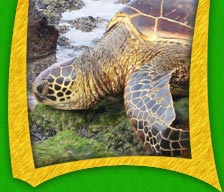|
OCEAN EXPLORERS
Having changed little in over 100 million years, sea turtles are
some of the oldest and most resilient creatures on Earth. These
ocean dwellers are able to swim incredible distances, stay underwater
for hours at a time, and even traverse entire oceans. By detecting
subtle variations in the earth’s magnetic field, sea turtles
create a geomagnetic map of their location. This helps to guide
them underwater. Imagine a built-in global positioning system
(GPS) for turtles!
Of the seven different species of sea turtles
found on Earth, Florida’s beaches are home to five: Loggerhead
(Caretta
caretta), Green Turtle (Chelonia mydas), Leatherback (Dermochelys
coriacea), Kemp’s Ridley (Lepidochelys kempi), and
Hawksbill (Eretmochelys imbricata). To properly identify
each species, scientists look at the quantity, shape and type of
scutes located on the upper and lower shells (carapace and plastron).
To differentiate between sexes, males have a long thick tail, while
females possess shorter stubbier ones.
HERE COMES BABY!
The Archie Carr National Wildlife Refuge, a 20-mile stretch of
sandy beach off Florida’s east coast is considered by many
the most important sea turtle nesting site in North America.
Its warm, soft sands attract one quarter of all marine turtles
within the United States. Each year, between March and October,
adult female Loggerheads, Green Sea Turtles, and Leatherbacks
crawl ashore at night to lay ping-pong ball sized eggs. Once
these are safely in the ground, females camouflage the nest and
return to the ocean, leaving their young to hatch and fend for
themselves.
Like other reptilian species, ambient temperatures dictate the
sex of the animal; warmer sands tend to produce more females, while
cooler sands tend to produce more males. After a two month incubation
period, baby sea turtles hatch from their shells and begin the
laborious process of digging to the surface and crawling towards
the sea. In order to travel in the right direction, sea turtles
use visual clues as a guide--usually the brightest horizon or the
night sky reflecting off the ocean. Once a male hatchling leaves
the sand, rarely does he return to land; on the other hand, some
mature females will travel extraordinary distances to lay eggs
on the very same beach from which they were hatched (natal
beach).
A BEAUTIFUL TOP
Love is in the air…or in the water! Believed to be the most
beautiful of all marine turtles, juvenile Hawksbill Sea turtles(Eretmochelys imbircata)
posses a heart-shaped carapace, and are commonly found in hard-bottom
and coral habitats. It’s easy to see why this turtle got
its name; its mouth resembles that of a hawk. This bird-like feature
allows for easy picking at jellyfish, urchins, crustaceans and
other creatures. Unfortunately, the Hawksbill’s tortoise-colored
shell has also been its curse. Exploited for centuries, fishermen
made jewelry, leathers, oils and cosmetics from its carapace and
other parts. Increased hunting and loss of habitat have placed
this animal on the endangered species list and as a result, international
trade of Hawksbill products has been prohibited in many countries
around the world.
Resources for this article
have been provided by the Caribbean
Conservation Corporation and Sea Turtle League, Wikipedia and
the Florida Fish
and Wildlife Conservation Commission.
|







